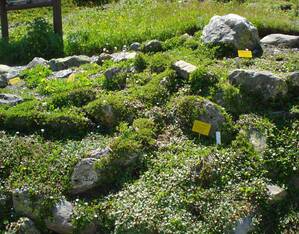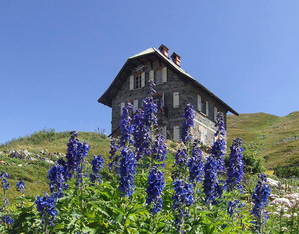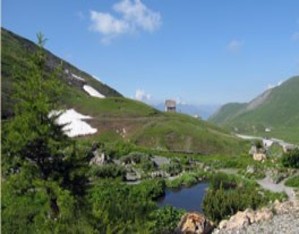The Ospizio del Piccolo San Bernardo garden is without doubt the oldest and arguably the most beautiful alpine garden in Europe. At an altitude of 2,170 meters, it is set in a landscape of pure beauty marked by a crown of snow-capped peaks.
Covering almost a hectare of land, this Alpine garden is one the world’s oldest botanical experiments; it is certainly the highest in altitude. The garden was named after its founder, Abbot Pierre Chanoux (1828-1909), who for years was Rector of the nearby Ospizio del Piccolo San Bernardo. Acting on an insight years ahead of his time, the Abbot set out to conserve alpine flora not just in herbariums, but to display it in living form in a botanical garden. An initial design, dating back to 1880, never saw the light of day. However, after building support among his wide circle of acquaintances, he convinced botanists and members of the C.A.I. to sign a subscription. The Municipality of La Thuile subsequently donated a plot of land to the east of the Hospice on which to conduct his experimentation. A few years later, the garden was officially up and running. Assisted by Geneva-born nurseryman Henry Correvon and by botanist and naturalist Lino Vaccari, who would later take over the garden, Chanoux officially inaugurated his Alpine garden in 1897. Botanist Vaccari would later add a small museum, which helped to bring the garden to international prominence. The buildings and collections were destroyed and abandoned during and after the war. The Alpine garden we see today was re-arranged in 1976-78. The garden’s collection of some 1,200 species is sub-divided into nine different botanical variety areas: siliceous cliffs (with various species of crustose lichens), siliceous scree (low-growing plants with a pulvinus), calcareous cliffs (typical of the Alpine region, different types at different altitudes and exposures), calcareous scree (species able to survive in low humidity), natural alpine grassland, megaphorb (herbaceous plants accustomed to constant and considerable humidity), a pebbly riverbed environment (hostile, for very hardy plants), and a peat bog with nearby pond and wet meadows.




